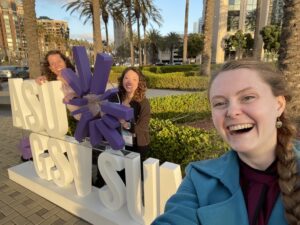ASU+GSV was an exciting opportunity for philanthropists, educators, nonprofits, and innovators to discuss and align edtech initiatives and materials aimed at increasing access and inclusion in education. 
With 20,000 industry leaders from 137 countries attending hundreds of sessions, it seemed as if there were several conferences within the conference. However, it was the spaces where sectors overlapped to create various pathways to impact that I found particularly exciting and inspirational. Below are three key elements I found particularly memorable:
1. The National Educational Technology Plan is addressing technology access, design, and use barriers
To make edtech as inclusive as possible, the US Office of Educational Technology (OET) is setting a vision to transform learning, including supporting and fostering three potential areas for impact:
- Access: The US government is making significant progress towards increasing students’ access to digital experiences. The 2013 ConnectEd initiative has greatly increased the number of schools with high speed internet, and the 2021 Affordable Connectivity Program subsidizes device and internet costs for low-income families to expand digital access to students’ homes.
- Design: OET is calling for an ecosystem of inclusivity focused entrepreneurs and innovators, recognizing that product design needs to be inclusive of students’ lived experiences and individual variation. Organizations such as English Learners Success Forum are meeting this need, providing guidance to help product developers create more inclusive, quality materials designed to support all learners.
- Use: Strategies to support effective adoption and use of materials include products that connect core curriculum materials with supplements, assessments, and teacher-family communication tools, in addition to professional learning support to empower teachers with the skills and knowledge necessary to leverage digital tools effectively.
2. Nonprofit resources are improving access and inclusivity
We heard from leaders of several nonprofit organizations who are developing resources to increase education quality, access, and inclusivity. These include:
- EL Education, a well-established professional learning and English Language Arts (ELA) curriculum provider, focuses on empowering teachers to create equitable and inclusive learning experiences for students. Their high-quality K-8 curriculum is available as a free Open Educational Resource (OER) to increase user access. Designed with inclusive strategies such as asset-based instruction, English Language Learner supports, and embedded social-emotional learning, teachers are supported via a suite of professional development tools and resources.
- OpenSciEd, a nonprofit science curriculum developer, offers an OER version of their curriculum that is free to download to increase access to high-quality science education aligned to the Next Generation Science Standards. They also partner with distributors who package their materials into digital and physical products that meet school districts’ needs.
3. Community-informed data is helping education leaders improve equity
Particularly inspiring to me is work by the nonprofit Beloved Community to inform education leaders by collecting and analyzing actionable data. The organization centers its approach on a philosophy that “people change systems,” leaning on equity audits to help organizations identify changes that can make meaningful near-term impact.
Awa, a free digital DEI self-assessment tool created by Beloved Community, leverages easy-to-use technology to give people the tools they need to create impact. Performance metrics, internal self-assessments, and process metrics (questioning assumptions about what is ‘standard practice’), are used to hone in on key equity breakdown points and inform actionable next steps.
An example of how this data can drive equitable change could be a scenario where the teacher population does not reflect a school’s regional demographics. A deeper dive into hiring practices can detect whether that disparity started in applications received, interviews scheduled, offers made, or who accepts offers. If offers made were representative but acceptances were not, then a next step would be to interrogate what signals about school and/or district culture could be reducing the appeal to prospective new teachers.
ASU+GSV convened a passionate cohort of problem-solvers, thinking critically about opportunities to meaningfully impact students’ learning and improve their social-emotional experiences of school. This is an exciting time to see how thoughtful advances in education technology will continue to help address intractable education problems, perhaps leading to that brave, new world where educational systems, products, and practices celebrate and meet the diverse needs of students to drive equitable access to the future.